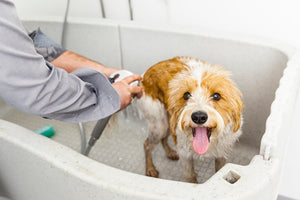How to Treat Dog Wounds at Home
October 04, 2017

There's nothing scarier than your pup getting hurt at home or at the dog park. For natural selection reasons dogs do an awesome job of hiding their pain. It can be difficult to even know when your dog is hurting or sick. Thankfully, we have the tools to be able to help our furry friends at home if the wounds are not so bad they need a veterinarian's help. Any injury that fully penetrates the skin (e.g., a bite wound) or involves a large portion of the body or an especially sensitive area should receive immediate veterinary attention.
We're going to talk about the equivalent of a scraped knee or shallow cut. Even minor wounds should be dealt with promptly, before infection sets in. If the skin around the wound is red or pus is visible, more aggressive treatment is probably necessary outside of the home.

Supplies Needed
Steps to Treat a Dog Wound at Home
- If you have a small pup, place him on a table or counter in front of you or get down on the ground with your large dog. Have a second person gently restrain your pup if necessary.
- Cover the wound and surrounding area with a water-based lubricant. This makes removing shaved hair from the wound much easier and decreases contamination.
- Use electric clippers to shave their hair from around the wound. Scissors or a disposable razor can be used with extreme caution to avoid cutting the skin.
- Wipe the water-based lubricant and hair away with a clean, dry cloth or paper towel.
- Wash the area with warm water until all visible debris is gone, then pat dry.
- Apply a non-stinging antiseptic solution to the area. Chlorhexidine spray is ideal because it kills the types of bacteria and yeast that are most commonly associated with skin infections in dogs and cats. Chlorhexidine wipes are double-sealed to lock in moisture, always ready to treat hard to reach areas like ears, groin, folds, wrinkles and around the legs.
- Apply an antimicrobial ointment to the wound. Traumatic injuries are best treated with a broad spectrum topical antibiotic like those containing bacitracin, neomycin, and polymyxin B. If yeast is of primary concern, for example in dogs with allergies that develop moist dermatitis, miconazole ointment is a good choice.
- Prevent your dog from grooming the ointment off its skin for at least ten minutes; longer is even better. Take your pup for a walk but do not apply a bandage over the area.
- Two to three times a day, clean away debris with Chlorhexidine shampoo (if necessary) and apply the antiseptic and ointment until the skin is healed.
Taking care of our pups and making sure they're happy and healthy is key in keeping us happy. Nothing is more sad than seeing those puppy dog eyes looking back at you when they're in pain. Try these tips the next time your pup gets hurt.
Featured Products from this Post:

